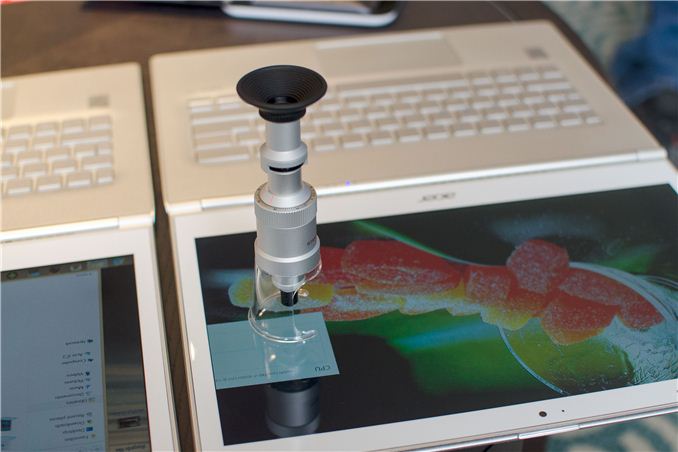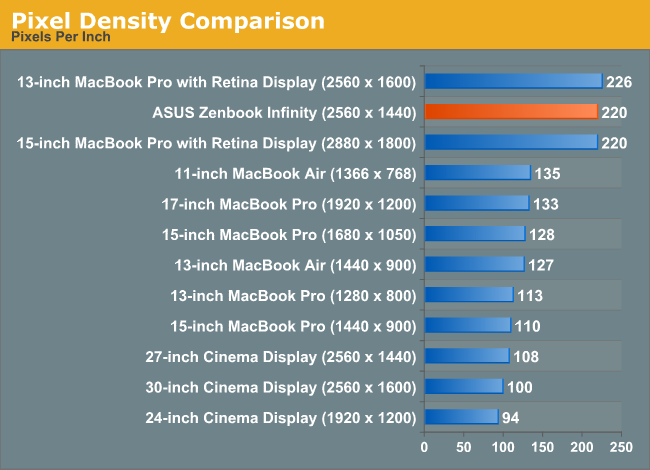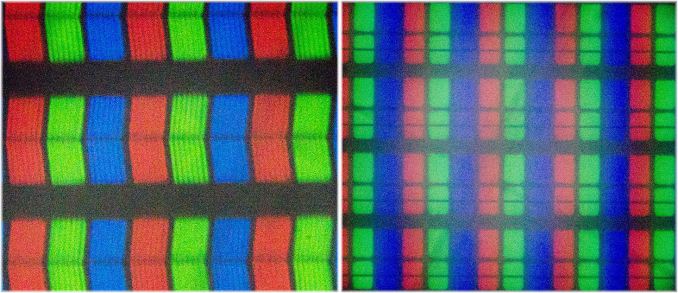Up Close with the 13.3-inch 2560 x 1440 Panel on Next-Gen Ultrabooks
by Anand Lal Shimpi on June 6, 2013 9:05 PM EST
Although entry level PC notebooks will still ship with a 1366 x 768 panel, the high end of the market is quickly shifting to 1080p and higher resolution panels. Some of the most interesting notebooks at Computex launched with high DPI panels, such as the new Acer Aspire S7 and the ASUS Zenbook Infinity - both with 13.3" 2560 x 1440 displays. These displays offer comparable pixel density to Apple's MacBook Pro with Retina Display.

Intel had one of the 2560 x 1440 Aspire S7s at their Computex suite as well as a microscope for showing off the difference in pixel size. With a 33% increase in pixel density, the 2560 x 1440 panel obviously has smaller pixels.
There's nothing new about increasing pixel density, however OS support/integration is just as important to the overall experience as physically outfitting notebooks with high DPI panels. Windows has traditionally done a terrible job of DPI scaling on the desktop, but word around Computex is that this should be fixed with Windows 8.1.











38 Comments
View All Comments
Meaker10 - Thursday, June 6, 2013 - link
You catch the msi 3k edition? 15.6 inch with 2880x1620 matched with 780m and 4930mx.jaroche - Thursday, June 6, 2013 - link
> "Windows has traditionally done a terrible job of DPI scaling on the desktop"How exactly is this a Windows fault? Applications need to tell they're DPI aware, and propertly support it. Windows tries to upscale low resolution icons, but its application's fault if it looks bad at High DPI. It's like complaining that Chrome looks bad (and IE10 doesn't).
EnzoFX - Thursday, June 6, 2013 - link
What about even basic system UI elements? I don't think those scale well either.Klimax - Friday, June 7, 2013 - link
They do. At minimum since XP...Spoony - Friday, June 7, 2013 - link
It's really a mixed bag. I have a rMBP and I use Windows on it often. Windows 7 scales poorly. Even the base OS is full of ugly. It is usable, but it's a long way from working properly (Win7x64 is also still retarded about its expectations at boot time).Windows 8 is significantly better in all respects. Metro is all just fine. When you go to the desktop layer much has been fixed. There's glitches here and there but overall I would say the improvement is significant. Very usable.
Programs are where things fall apart. Office 365 seems to do a pretty good job, as do some of the flagship Win8 Microsoft bundled applications (IE). However, outside of that it's the wild west. 3rd party programs are almost universally horrible, and all of Microsoft's unconverted software is equally lame. Unsurprisingly games are commonly the most compatible, able to select and use the very high resolutions (although sometimes the U/I assets are half size).
JDG1980 - Friday, June 7, 2013 - link
As these HiDPI screens become more popular, the application vendors will have to fix their products.JDG1980 - Friday, June 7, 2013 - link
Since Vista, the way DPI scaling works in Windows is this: If the underlying app says "I'm DPI-aware" in the manifest, then the OS trusts it and lets it display the way it wants. If that flag is absent, then the window is drawn at standard DPI to an offscreen buffer and then upscaled to the correct DPI setting during rendering. It will look fuzzy, but should not have any out-of-place or missing elements (as the XP scaling method sometimes did).Unfortunately, there's nothing stopping an application from saying "I'm DPI-aware!" when it's really not. This is where most of the errors come from.
Currently, Adobe has fixed Lightroom to work with HiDPI settings properly, but Photoshop hasn't been done yet. They say it will be done soon, but who knows if that will be ported to CS6 or if you'll have to shell out the monthly "cloud" fee to get this basic fix. Acrobat hasn't been fixed to support HiDPI either.
Firefox 21 doesn't properly support HiDPI, but Firefox 22 will.
pixelstuff - Thursday, June 6, 2013 - link
Still doing the 16:9 ratio I see. I still wish they would move back toward the taller displays. If someone would offer the Chromebook Pixel hardware with Windows on it, I sure would like to try it. In my opinion 16:10 is the minimum height. 4:3 might be taller than needed.I would like to directly compare 16:10 with 3:2 to see which is better.
mjz - Thursday, June 6, 2013 - link
thats why i get apple laptops.. taller displays than the typical PC laptopseallan - Thursday, June 6, 2013 - link
Google Pixel??